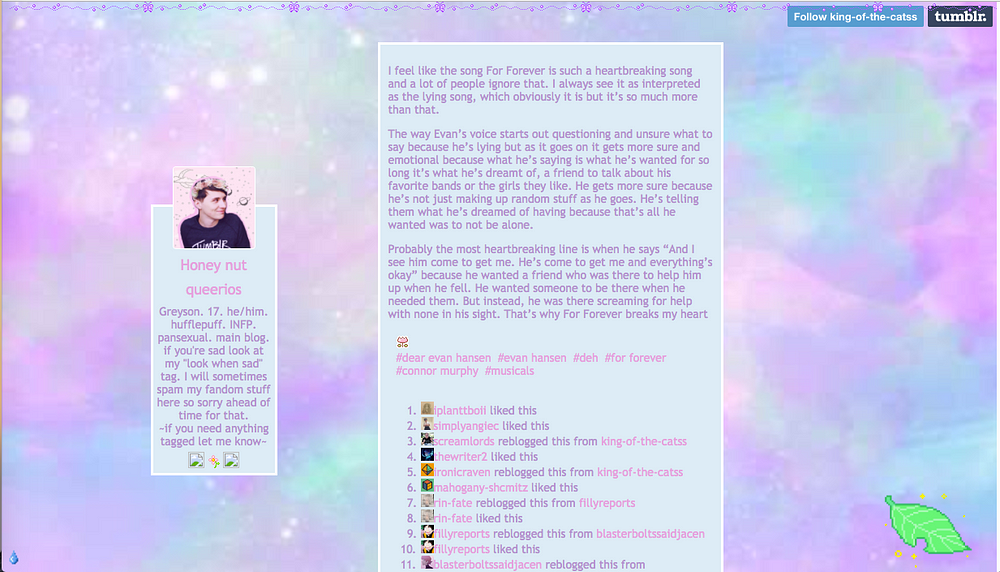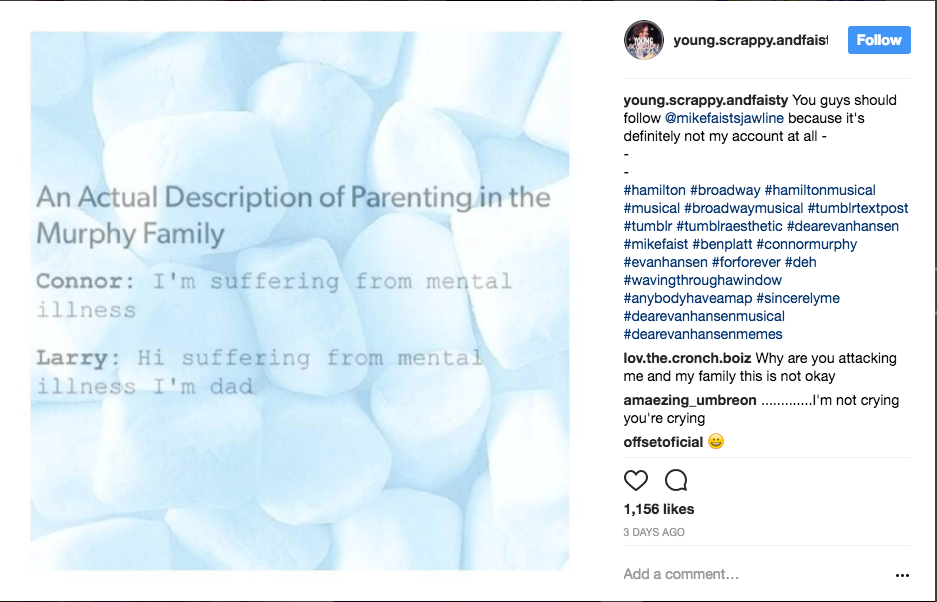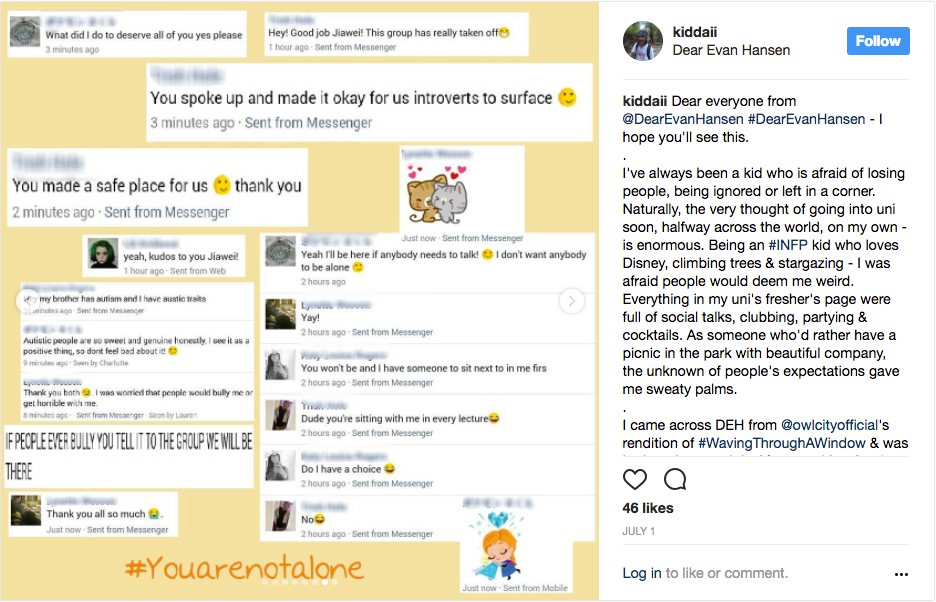‘Fansens’ Are Waving Through A Window: Exploring the ‘Dear Evan Hansen’ Fan Phenomenon
Jarrod Walczer & Derek E. Baird | Journal of Fandom Studies

Dear Evan Hansen is a cultural phenomenon and Tony Award-winning musical that has been widely celebrated by a social media-driven fan community, known as ‘Fansens.’
The growth of this fandom on social media is unique as Fansens have adopted plot points and thematic elements from the musical relating to how social media affects social anxiety, depression, and suicide to create fan art and fanfictions, which, in turn, result in a community of care on social media where fans can discuss their own encounters with social anxiety, teen suicide, and cyberbullying.
Though most Fansens would not have seen the musical performed on Broadway or live in person, their fanfictions, personal posts, and fan art reflect and refract the difficulties that young people have with mental health, social anxiety, and suicide.
This article analyzes numerous fan cultural artifacts collected from DEH-specific hash-tagged posts on Tumblr and Instagram using digital and post-structuralist textual analysis.
In doing so, our article, appearing in the November 2020 (Vol 8, Issue 2) edition of the Journal of Fandom Studies, provides a new perspective on the role that fan communities, their artifacts, their use of digital media, and their fan activist and upstanding techniques can play in providing avenues of self-care and modeling positive online support for those dealing with mental health issues.
Does ‘Anybody Have A Map?
Have you ever felt like nobody was there?
Have you ever felt forgotten in the middle of nowhere?
Have you ever felt like you could disappear?
Like you could fall, and no one would hear?
(Pasek and Paul, 2016)
Dear Evan Hansen (hereafter, DEH) premiered in July 2015 and would later open on Broadway in December of 2016. The musical’s narrative centers on high school senior Evan Hansen (a role originated by Ben Platt) who struggles with an anxiety disorder.
Evan, who struggles to make friends and is often bullied at school, writes letters to himself at his therapist's suggestion about why each day will be good. This becomes the catalyst for the musical’s plot.
As DEH rose in popularity, Evan Hansen was said to have become a veritable patron saint of young people’s social anxiety. Pasek and Paul’s lyrics also became a genesis for an online social movement rooted in young people decoding shared experiences of social anxiety, bullying (online and offline), and the awkwardness of being a 21st-century teen.
In-experiences — or in this case — of viewing a live musical theatre performance, combined with a shared empathy over the plotline, were quickly augmented by networked youth audiences’ desire to share their experiences and feelings on visual social media platforms like Instagram and Tumblr.
Moreover, the mental health experiences explored by Evan throughout the production are widely understood by the young fanbase, many of whom use social media to find emotional support for the same or similar issues.

As numerous musical fans demonstrated their deep and emotional involvement with DEH through fanfiction, fan art, and written testimonials about how DEH impacted their mental health, we determined that the DEH fan community, hereafter Fansens, required further examination.







Evan, Teens, Mental Health & Community
Our objective in writing this article is to show how the Fansen community used DEH to create a new type of fan activism: one where members of the community likely have not engaged with the primary text (seeing the musical live in-person); one where a theatre fandom is largely based online, one where a Broadway play uses the Internet as a central plot point to discuss teen difficulties with mental health, social anxiety, and suicide; and one where fans reflexively use visual social media platforms to create fan cultural artifacts as a means of combatting the same concerns about online mediated mental health, social anxiety, and suicide demonstrated in the musical, in their everyday corporeal and digital lives.
By examining the emotional resonance between the characters, plot points, and music of DEH, and the fandom that spontaneously grew around it, we maintain that fandom studies scholars can gain a richer understanding of how visual media and fandom can be used to foster unity among young people and combat social issues both on social media and in the corporeal world.
Our article argues that Fansens, by assuming and remixing the themes, lyrics, and plot points of DEH, have followed and furthered the musical's implicit messages. By exploring the musical’s presentation of social anxiety, depression, and teen suicide; how it was received, interpreted, and utilized by fans; and how it circulated on popular social media, we explain how and why the online Fansen community developed, despite the musical being geographically bounded to stage, and the implications that their fan activism and upstanding (a term popularized by the 2012 documentary The Bully Project, describing someone who does not allow others to be bullied by defending them techniques could have on fandom studies moving forward).
Read our full research study on ‘Dear Evan Hansen’ fan culture in the Journal of Fandom Studies, by clicking here.
Methods
By analyzing the mediated texts created by the Fansens using post-structuralist textual analysis, we endeavor to understand Fansens better and explain the Fansen community’s dominant meanings behind these texts and their uses gratifications of reading and remixing the musical online.
Images were hand-selected from a larger sample of posts scraped from public Instagram and Tumblr accounts that used Dear Evan Hansen specific hashtags. Dear Evan Hansen provides an additional perspective on the role those fandom communities and their resulting posts, fan art, and discussions can play in providing avenues of self-care, modeling positive online support, and inspiring upstander behaviors for those dealing with mental health issues.
API Tools
The Fansen media texts analyzed were sampled from systematically gathered collections scraped from the application programming interfaces (API) of Instagram and Tumblr, using the Instagram Hashtag Explorer and the Tumblr Tools created by The University of Amsterdam. Four show-specific hashtags: #deh, #dearevanhansen, #wavingthroughawindow, and #youwillbefound were analyzed in this work.
Visual Analysis
We selected and analyzed ten posts from both Tumblr and Instagram per hashtag that we felt were both representatives of the corpus of DEH posts on both platforms and displayed a diverse set of visual narratives and upstanding techniques used by the overarching ‘Fansen’ community.
These were hand-selected from over 490,000 posts with #dearevanhansen hashtags, 220,000 posts with #deh hashtags, and 109,000 posts #youwillbefound hashtags, and 7,500 posts with #wavingthroughawindow hashtags on Instagram.
A similar logic was used for Tumblr but was automated through the TumblrTool created by The University of Amsterdam’s Digital Media Initiative, allowing us to sample 710 posts with #dearevanhansen hashtags, over 2,000 posts on Tumblr with #deh hashtags, 213 posts with #youwillbefound hashtags, and 48 posts with #wavingthroughawindow hashtags.
The posts captured and analyzed for this research were publicly available, visible, and under Instagram and Tumblr’s platform agreements and settings.
About the Authors
Jarrod Walczer, Ph.D. (ABD), is a media and communications doctoral candidate who fuses cultural studies with digital methods to explore the impact toy unboxing creator culture on YouTube has had on the children’s media industry in the US.
He received his M.A. from The University of Southern California’s Annenberg School for Communications and Journalism, his M.Sc. from The London School of Economics & Politics, and his B.S. from The Roy H. Park School of Communications at Ithaca College. He is currently pursuing his Ph.D. in Media and Communications at the Queensland University of Technology (QUT)’s Digital Media Research Centre.
Derek E. Baird, M.A is a leading kid and teen expert & author who helps brands, educators & parents connect to kids & teens through culture, social media & technology. He is the author of The Gen Z Frequency (Kogan-Page, 2018), translated into Chinese, Vietnamese, Ukrainian, and German editions.
Derek has worked on social media, kidtech, cultural strategy, and emerging technology projects for Yahoo! Southeast Asia, Facebook, HBO, The Walt Disney Company (TWDC), Disney Yellow Shoes, Yahoo!, and The Museum of Tolerance. He has also worked as an adjunct instructor in education technology at Pepperdine University Graduate School of Education and Psychology (GSEP).
He can be found online at https://www.derekebaird.com/ and is @derekeb on Instagram.
